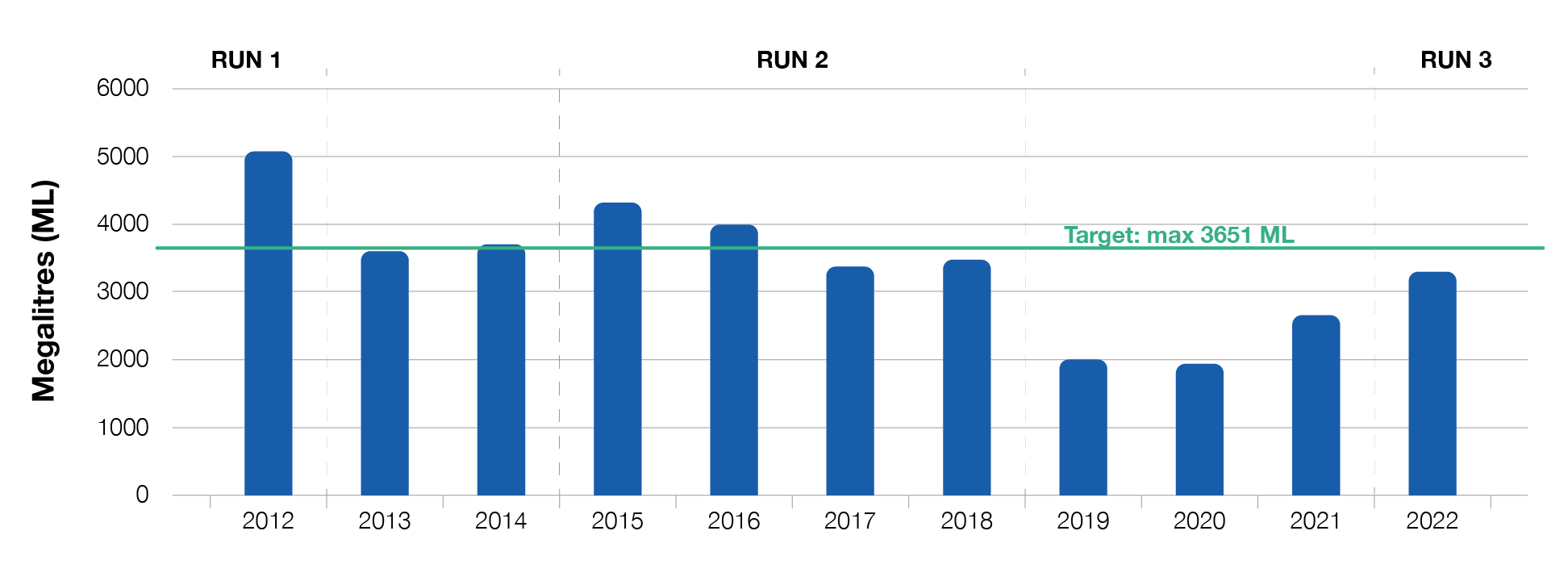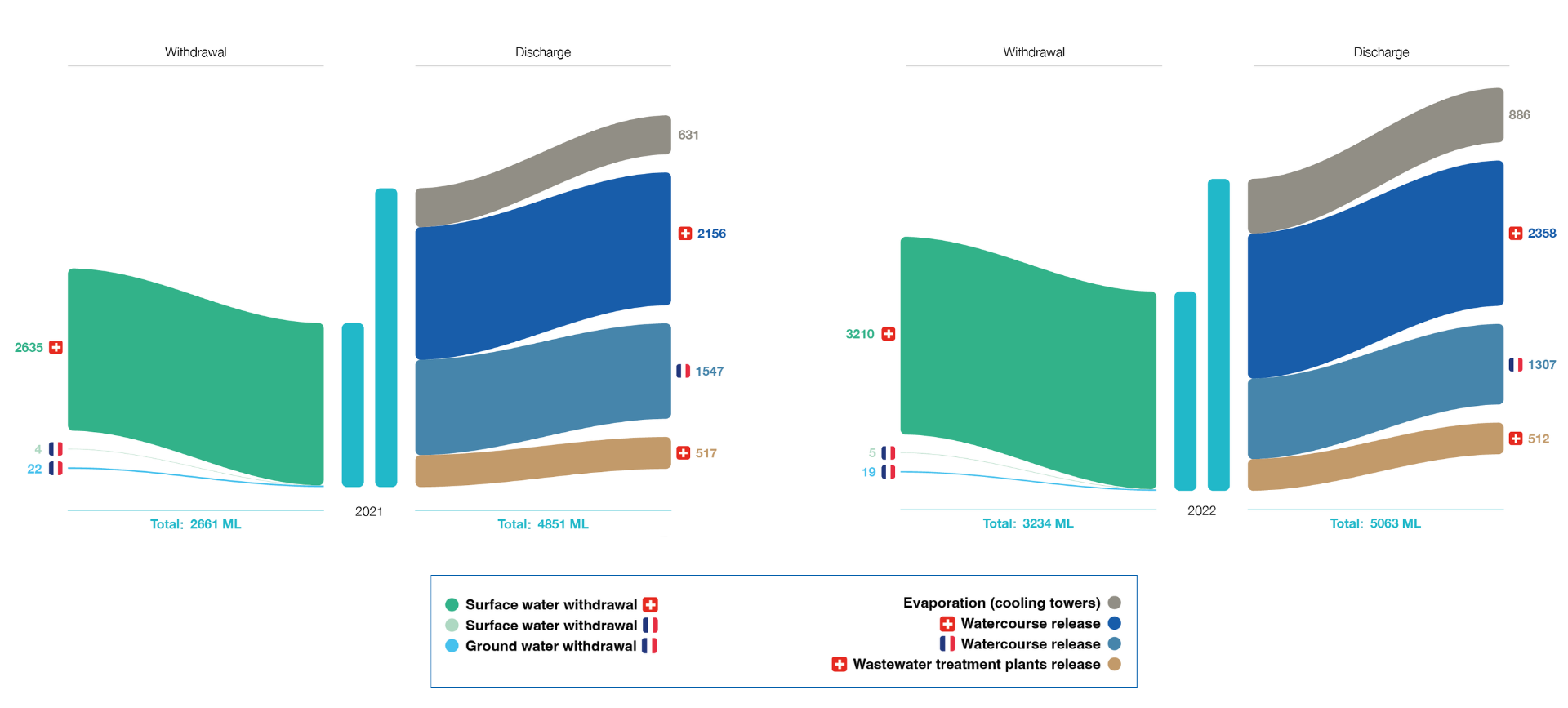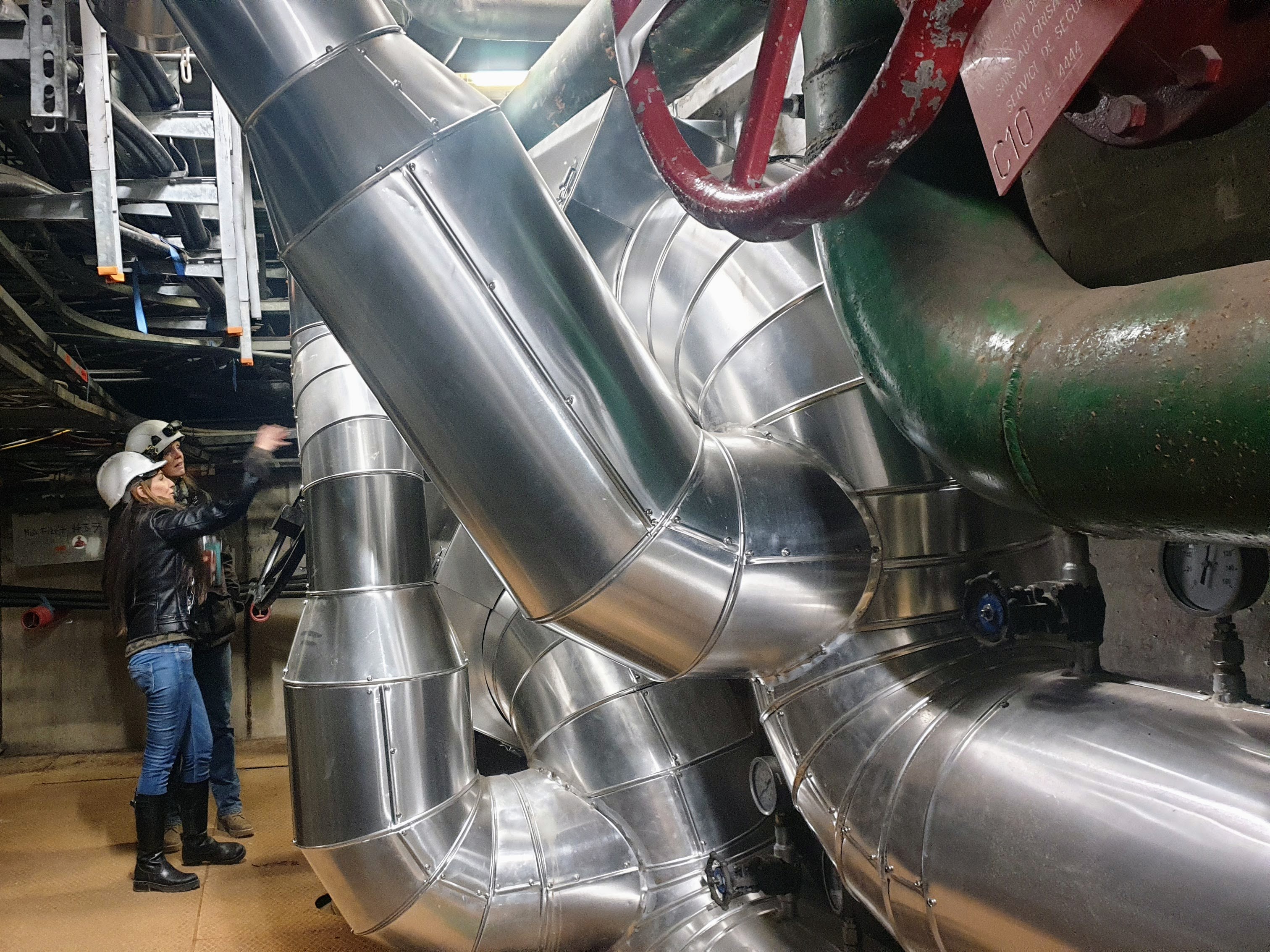Water and effluents
CERN Environment Report 2021-2022
Water is essential for the cooling systems of CERN’s scientific facilities, and responsible water management is of the utmost importance to the Laboratory.
Water withdrawal and consumption
CERN strives to minimise its water consumption through continuous consolidation and improvement of its cooling and sanitation infrastructures. Since 2000, CERN has radically decreased its water consumption by some 80%, from 15 000 megalitres that year to 3234 megalitres in 2022, notably by changing the water circuits in its cooling towers from open to semi-open or closed ones during LS2.

All water supplied to CERN is of drinking quality and is either used as is or demineralised. The Services Industriels de Genève (SIG) supply most of CERN’s water, which comes from Lake Geneva. About 1%, consisting mainly of groundwater, is provided by the Régie des Eaux Gessiennes in the Pays de Gex, France, which is a water-stressed area. The suppliers send monthly or annual water consumption reports, allowing CERN to monitor its water use.
Around 80% of CERN’s water supply is dedicated to industrial activities, primarily the cooling of the accelerator complex, the detectors and computing facilities, and 20% is used for sanitation purposes. As of 2021, and especially since the restart of physics after the Large Hadron Collider’s (LHC) second long shutdown (LS2), the amount of water required to cool the research facilities has gradually increased. Nonetheless, CERN’s overall water consumption in 2021 and 2022 (2661 and 3234 megalitres, respectively) was lower than in its previous operation year, 2018 (3477 megalitres), due to the gradual ramp-up of accelerator and detector operation after LS2.
Water discharge and monitoring
The Organization releases rainwater, infiltration water and cooling water into local watercourses, some of which are small and sensitive to the quality of the effluents they receive. CERN regularly samples the neighbouring watercourses to evaluate its impact and reports on its monitoring programme to the Host State authorities on a quarterly basis. Effluent quality is continuously monitored according to CERN-defined criteria that are compliant with Host State regulations. Intervention plans exist as part of CERN’s emergency preparedness in the event of an incident. The Laboratory has procedures in place to mitigate the consequences and to alert the relevant Host State authorities and emergency services. No event detrimental to the environment that would have led to a fine or non-monetary sanction occurred during the period covered by this report (see Environmental compliance and management of hazardous substances).

Effluent quality
CERN’s cooling towers evaporate some of the water used for cooling the accelerators. Some is also released as effluent water. The latter contains residuals of treatments used to prevent scaling, corrosion and bacteria, including legionella. To minimise the quantity of effluents and improve their quality, the Organization is modifying its cooling towers, either by adding demineralised water or by installing a system to recycle the blowdown water. This has led to a reduction in releases to the neighbouring watercourses. 70% of the circuits were modified during LS2 and the remainder will be adapted during LS3, starting in 2026.
As a result of increased activity in the North Area of the Prévessin site, with concomitant increase in water flow, a new water monitoring station was installed in January 2022 to check the quality of the effluents released into the nearby Lion river.
CERN’s new retention basin downstream of the Prévessin site, which includes a hydrocarbon separator for treating accidental pollution, has proven effective in regulating the flow and ensuring the quality of water releases from the site. An additional retention basin will be built inside the Prévessin site in 2023 to manage stormwater runoff surplus.
On the Meyrin site, CERN is studying the construction of a new retention basin to collect rainwater using an existing installation under one of the hostel buildings. For the last few years, all new projects on the Swiss watershed of the Meyrin site have included retention basins, either on the roof, buried, or in the open air when possible.
The Charter of the Nant d’Avril also includes plans for new retention basins to regulate the flow into this watercourse, as well as improvements in the quality of effluent coming from the cooling towers. The quality of CERN effluents is discussed with the local Host State authorities in the framework of the tripartite committee for the environment.
RENOVATING WATER NETWORKS AT CERN
In 2021, the Laboratory started its ten-year Technical Galleries Consolidation programme to refurbish the 80 galleries and their related infrastructure. One part of this project concerns the renovation of the water circuits, such as those that supply drinking water and water used by the CERN Fire and Rescue service (see In focus below). The project further encompasses the sewage and sanitation networks, for which pipe permeability is an issue, and the implementation of a procedure to control the infiltration of water into the accelerator tunnels. An in-depth inspection campaign to update the mapping of the full network began in 2022.
LOOKING AHEAD
As for all other objectives set in the first environment report, the target year, which was originally 2024, has shifted concomitantly with the change in the accelerator schedule. CERN is now committed to limiting its increase in water consumption to 5% by the end of Run 3 in 2025 (baseline year 2018).
In preparation for the high-luminosity era of the LHC (HL-LHC), CERN has approved the construction of a cooling water recycling plant at Point 1 of the LHC ring. It will collect and process the water from the LHC and SPS cooling circuits with a view to recycling and reinjecting it at Point 1. Residual effluents from the treatment process will be released into the sewage network, thus reducing the impact on the Nant d’Avril river. Building this recycling plant will also help keep water consumption down in the future, when the need for cooling will increase due to the HL-LHC and the LHC experiment upgrades.
Given the increased computing capacity that will be required, a new data centre, due to come online at the end of 2023, is being constructed in Prévessin. It will be cooled using the latest technologies to achieve high power efficiency. Dry coolers will provide adiabatic cooling during hot periods, which will lead to water savings. In addition, a recirculation circuit will be added to the dry coolers to further minimise the amount of water used. The new data centre will also recover heat to warm all 73 buildings on Prévessin site (see Energy).
In focus

Esther Amarilla is the work package leader for cooling and ventilation in the Technical Galleries Consolidation programme.
— How did this project come about?
EA: Some parts of the networks are more than 60 years old and in dire need of refurbishment and replacement. For the water networks, we did a full status review in 2021, in close collaboration with SIG, as they supply the water and know the typical shortcomings of this type of network. Starting with the west area of the Meyrin site, where the impact on CERN’s scientific activities will be the slightest, we will work in stages over the course of ten years to replace the network on both the Meyrin and the Prévessin sites.
— What are the main objectives of replacing the drinking water networks?
EA: It’s a matter of increasing the reliability of the various networks, such as drinking, cooling and effluent, and improving their water quality. Replacing the old networks will minimise the risk of leaks. The piping volume will be reduced in the new design, diminishing the risk of stagnant water. It is a very ambitious programme that is invisible to many, but highly impactful.
Learn more
Questions regarding this report may be addressed to environment.report@cern.ch.
